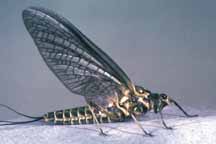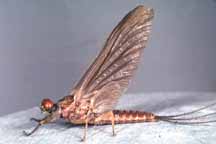
![]()
Trips
Montana
Missouri
SW
Montana
Clark Fork & Bitterroot
Bahamas
Andros Island
Upper Delaware
Other Destinations
Alaska
New Zealand
Argentina
Chile
![]()
News
![]()
River Updates
Hatch
Chart
![]()
Campground
![]()
Tips
Articles
ACFF
Photo Gallery
![]()
Al Caucci's Biography
Testimonials
![]()
Contact Us
Home
![]()
Your fishing logs at Ecolure
![]()
Friends of the
Upper
Delaware
![]()
1250 Winterdale Road
Starlight, PA, 18461
Phone : 1 ( 570 ) 635 - 5897
email : alcaucci@hancock.net

|
|||||||
|
The Early Season Hatches by Al Caucci The Early Season in the East and Midwest begins in April and usually lasts about four weeks in any given area. Southern Appalachian rivers may start as early as March, while those in northern Wisconsin, Michigan, New York's Adirondacks and New England may not begin until mid May. During cold flood years, hatching may be delayed a week or two. Drought years and warm weather can trigger hatching activity two to three weeks early. In some ways the Western angler may have it better than the Eastern because they have two early seasons. One prior to the run-off in April and a second after the snow melt in late June and early July. April fishing can be very risky though, due to unpredictable drops in temperature and snow storms which are synonymous with the Rockies. In the East and Midwest, the unpredictable Early Season can be characterized by sparkling spring days or chilly, drizzly days. During this period, the first hatches to produce dry fly fishing are midges, Early Black Stoneflies, (Taeniopterx), Early Brown Stoneflies (Brachytera), Tiny Black Stoneflies (Capnia) and Chimmara (Little Black) caddis. According to water temperature, water speed and depth, these hatches can produce decent dry fly fishing or it could be disappointing if the conditions are bad. My favorite hatches during the first half of April are the Taeniopterx and Brachytera stoneflies. They are a good size, #14 and #16 hook, and represent a good meal for lethargic early season trout. Look for slow current speeds below riffles and side eddies during the warmest part of the day when the water temperature reaches the mid to high 40's. The first mayflies on the scene in the East, Midwest and southern Appalachia are the Baetis (B.W.O.) and Blue Quills (Paraleptophlebia), they follow the early stones and caddis when the water temperature is consistently in the high 40's. Paraleptophlebia starts when the water temperature is above 50 degrees F. for a few days. Both hatches start as early as 11:00 A.M. and go through most of the afternoon. Best activity occurring at the warmest part of the day. On days when the air temperature turns cold, the duns have great difficulty thawing their wing muscles and ride the current for extremely long periods resulting in easy meals for the trout. When the water temperature reaches 52 to 55 degrees F. for a few days, you can expect the real action to start. The Quill Gordon (Epeorus pleuralis), Light Hendrickson (Ephemerella subvaria) and Dark Hendrickson (Ephemerella "x") plus the Brachycentrus caddisfly hatch causes great excitement. Unlike the sporadic surface activity provided by the early stoneflies, caddis and mayflies previously mentioned, these larger, meatier flies bring the big wild fish to the surface. Due to their size (#12's and #14's), the warmer water temperature and the prolific numbers of insects, every trout in the river seems to be conscious of every move these insects make. Once the Ephemerella's start to hatch, they will usually continue on a daily basis until they are hatched out.
The Epeorus nymphs migrate to the downstream sides of submerged rocks and boulders where they congregate a day or so prior to hatching. At emergence, they escape their nymphal shucks on the streambed and rise to the surface as a swimming dun, vulnerable and disoriented. Imitations suggestive of emerging duns both twitched and fished dead drift are very effective. No hatch fills a trout stream quicker with flyfishers than the "Hendrickson Hatch", and for good reason too! Highly concentrated emergences of fat, vulnerable bugs, optimum water temperatures of 52 to 58 degrees F., plus the advantage of mid afternoon lighting really turn the trout and the anglers on! The Light Hendrickson (Ephemerella subvaria) and Dark Hendrickson (Ephemerella "x") are truly the kings (or queens) of the early season. On my home rivers, the West Branch, the East Branch and the Main Stem of the Delaware, there are as many as six sub species that fall within the general description in terms of size, hatching period and coloration. This plethora of Ephemerellas insures "Hendrickson" hatches from late April through late May on a daily basis during a normal season (see Al's column "Bug Action" in the January/February 1997 issue Fly Fish America for some interesting information on subvaria and "x"). Toward the middle of the Hendrickson hatch, the prolific Brachycentrus caddisflies (#16, #14 Light and Dark Grannoms) start to emerge, causing even more ravenous feeding from lunker trout. Trout key on the emerging pupa from midday until the more vulnerable Hendrickson mayflies start to hatch, then they'll switch over to these vulnerable nymphs, duns and emergers until they are gorged. The Early Season western hatches that visiting anglers are accustomed to are bunched up in that period toward the end of the snow melt-usually late June and early July in the Rockies, and earlier on the West Coast streams coming out of the Cascades and Sierras. Hatching is determined by water temperature-unlike the East, the hatching sequences in the Rockies, Sierras and Cascades are extremely complicated due to vast mountain ranges and intangible geological influences. Some angling texts stress altitude as the key for predicting hatching activity. I have found this criteria alone to be an unreliable factor. Southerly exposures of high peaks, permanent glacial influences, thermal geyser activity and cold springs are only a few of the forces that will determine when water temperature will be right for hatching. Any one of these influences-or a combination of several-will determine if hatches will coincide on certain rivers, or whether they will be weeks or even months apart. This said, you can expect some great hatching at the end of the run-off, usually mid June to early July. The Salmonfly hatch (Pteranarcy californica) is the most popular hatch in the west. Fly fishers will juggle vacations to be in the right place at the right time. In reality, it is very unpredictable in its daily locations and hard to hit squarely, but if you hit it right you'll never forget it. Memories of lunker brows slamming big dry flies, and nymphs right on the shoreline, are with me still. The Madison, Big Hole, Henry's Fork, Yellowstone, Bitterroot, Big Blackfoot and Dechutes are a few good Salmonfly rivers. The Golden Stones (Acroneuria californica) follow the big Salmonflies and are more reliable and consistent in producing both dry fly and nymphing action. Tie tour imitations on size 8 hooks in 3x and 4x long. The Western Green Drakes (Drunella grandis and doddsi) also follow the Salmonfly hatch. These large, clumsy, vulnerable mayflies (size 10) produce excellent dry fly fishing to wild lunker trout. Emerger and nymph fishing during this hatch is also a blast. All this big stonefly and mayfly activity takes place in the afternoon, which is an added bonus. One of my favorite western hatches is the Dark Slate Winged Olive or Flav (Drunella flavilinea) in size 14. They make their showing about a week after the Green Drakes. On cloudy days, expect late afternoon hatches-on bright days they will hatch toward evening. The size 12 Gray Drakes (Siphlonorus occidentalist) and the pinkish Epeorus mayflies also make their appearance after the Green Drakes. Prior to the late May and June snow melts, westerner anglers can enjoy another early season. In late March, April and early May, long before the city anglers and tourists arrive from other parts of the world, the western rivers flow low and clear, and the natives have them all to themselves. As in the East, there are late winter, early spring hatches of Taneiopterx and Brachytera stoneflies that trigger good nymph and dry fly fishing. If you're lucky enough to get good weather during this period, the angler can expect good Brachycentrus caddis emergences (Grannom), in sizes 14 and 16 in afternoons, along with size 16 Blue-winged Olive (Baetis) mayflies. Western March Browns (Rithrogena morrisoni), in size 14, are prevalent mayflies in March and April, along with Skwala stoneflies. Skwala parallela (size 10) is found in Montana and is a major dry fly hatch in the Missoula area in late winter, especially on the Bitterroot River. Although I just returned from my Bonefish Schools three weeks ago, at this writing I already find myself afflicted with that dreaded disease-cabin fever. By the time you read this I should only be weeks away from casting a fly into the Delaware. In the meantime, I think I'll have a nip of the Macallan sitting on the other side of my tying vise. |
|||||||

